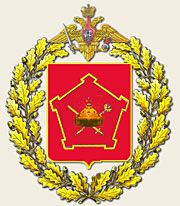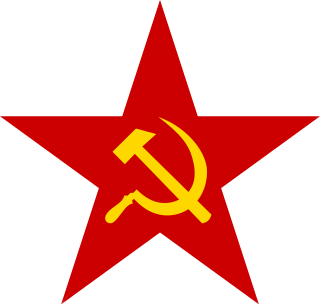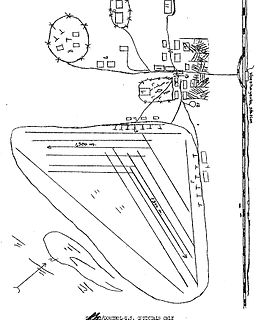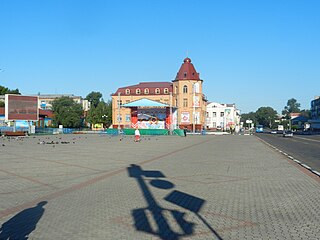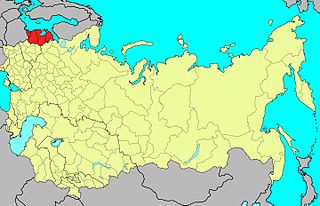| 265th Motor Rifle Division (1965–1989) 119th Motor Rifle Division 71st Mechanized Division 34th Separate Rifle Brigade 265th Rifle Division (1941–1946) | |
|---|---|
| Active | July 1941–October 1989 |
| Country | Soviet Union |
| Branch | Red Army |
| Type | Rifle division |
| Engagements | World War II |
| Battle honours | |
The 265th Motor Rifle Division (Russian : 265-я мотострелковая дивизия) was a motorized infantry division of the Soviet Army during the Cold War.

Russian is an East Slavic language, which is official in the Russian Federation, Belarus, Kazakhstan and Kyrgyzstan, as well as being widely used throughout Eastern Europe, the Baltic states, the Caucasus and Central Asia. It was the de facto language of the Soviet Union until its dissolution on 25 December 1991. Although, nowadays, nearly three decades after the breakup of the Soviet Union, Russian is used in official capacity or in public life in all the post-Soviet nation-states, as well as in Israel and Mongolia, the rise of state-specific varieties of this language tends to be strongly denied in Russia, in line with the Russian World ideology.
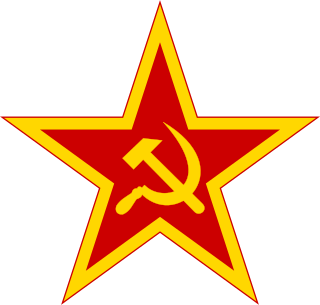
The Soviet Army is the name given to the main land-based branch of the Soviet Armed Forces between February 1946 and December 1991, when it was replaced with the Russian Ground Forces, although it was not fully abolished until 25 December 1993. Until 25 February 1946, it was known as the Red Army, established by decree on 15 (28) January 1918 "to protect the population, territorial integrity and civil liberties in the territory of the Soviet state." The Strategic Missile Troops, Air Defense Forces and Air Forces were part of the Soviet Army in addition to the Ground Forces.

The Cold War was a period of geopolitical tension between the Soviet Union with its satellite states, and the United States with its allies after World War II. A common historiography of the conflict begins with 1946, the year U.S. diplomat George F. Kennan's "Long Telegram" from Moscow cemented a U.S. foreign policy of containment of Soviet expansionism threatening strategically vital regions, and ending between the Revolutions of 1989 and the 1991 collapse of the USSR, which ended communism in Eastern Europe. The term "cold" is used because there was no large-scale fighting directly between the two sides, but they each supported major regional conflicts known as proxy wars.
Contents
The division traced its heritage back to the 265th Rifle Division, which was formed in mid-1941 from an NKVD division. The 265th fought in the Continuation War and the Siege of Leningrad through 1944 and the Battle of Berlin in 1945. Postwar, it was withdrawn to the Soviet Union and downsized into a rifle brigade before being expanded into the 71st Mechanized Division in 1953. It was relocated to Vilnius and converted into the 119th Motor Rifle Division in 1957 before relocating to the Soviet Far East in 1964 and being renumbered as the 265th Motor Rifle Division. It spent the rest of its career in the Far East and was downsized into a storage base in 1989.
The People's Commissariat for Internal Affairs, abbreviated NKVD, was the interior ministry of the Soviet Union.

The Continuation War was a conflict fought by Finland and Nazi Germany, as co-belligerents, against the Soviet Union (USSR) from 1941 to 1944, during World War II. In Russian historiography, the war is called the Soviet–Finnish Front of the Great Patriotic War. Germany regarded its operations in the region as part of its overall war efforts on the Eastern Front and provided Finland with critical material support and military assistance.

The Siege of Leningrad was a prolonged military blockade undertaken from the south by the Army Group North of Nazi Germany against the Russian city of Leningrad on the Eastern Front in World War II. The Finnish army invaded from the north, co-operating with the Germans until they had recaptured territory lost in the recent Winter War, but refused to make further approaches to the city.
